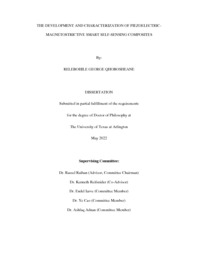
ATTENTION: The works hosted here are being migrated to a new repository that will consolidate resources, improve discoverability, and better show UTA's research impact on the global community. We will update authors as the migration progresses. Please see MavMatrix for more information.
Show simple item record
| dc.creator | Qhobosheane, George Relebohile | |
| dc.date.accessioned | 2023-06-27T23:53:20Z | |
| dc.date.available | 2023-06-27T23:53:20Z | |
| dc.date.created | 2022-05 | |
| dc.date.issued | 2022-06-01 | |
| dc.date.submitted | May 2022 | |
| dc.identifier.uri | http://hdl.handle.net/10106/31348 | |
| dc.description.abstract | The composites industry is expanding due to the growing global demand for high-performance materials. How do you ensure the production of composites is as smooth and effective as possible while maintaining the high quality of the material? The key issues in composites include crack occurrence, sticking to molds in the production process, and durability differences during their operation. However, monitoring such cases can be challenging. The industry is in need of a smart solution to be able to obtain accurate data from the raw material. This work focuses on the development of smart composite materials. The word composite comes from the word composed which means made up from. The application of composite materials has spread out through numerous industries in recent years. Composite materials experience different deformations that lead to failure in different applications. These have led to the demand and development of various structural health monitoring (SHM) techniques. This also entails the development and application of a wireless magnetostrictive senor for SHM applications. Glass fiber reinforced polymer (GFRP) and carbon fiber-reinforced polymer (CFRP) composites are selected in this work. The increasing demand for early detection of barely visible damage inside fiber-reinforced polymer (FRP) composites has led to the development of advanced microsensors capable of measuring local strains and defects within FRP composites. One of the major challenges in this type of local structural health monitoring (SHM) is the development of embedded sensors which can be safely placed into FRP composites while maintaining their high strength and lightweight.
The characterization of mechanical properties of the developed smart self-sensing glass fiber composite is also another objective of this work. A composite sample with both magnetostrictive property and piezoelectric property is manufactured. The magnetostrictive property is achieved by the addition of Terfenol-D nanoparticles within the composite constituents and the piezoelectric
property by the addition of single-walled carbon nanotubes (SWCNTs). The presence of these foreign materials within the composite system affects the overall composite mechanical properties. Composite prepreg samples of constant optimal nanoparticle volume fractions as per previous work are fabricated. Thermal properties will be investigated using differential scanning calorimetry (DSC). Bonding properties in the presence of the nanoparticles will be characterized using Nicolet 6700 FTIR Fourier transform infrared (FTIR). Different mechanical tests will be performed to predict the smart self-sensing composite performance, coupled with statistical and FEA models to give an in-depth understanding of these composites. | |
| dc.format.mimetype | application/pdf | |
| dc.language.iso | en_US | |
| dc.subject | Magnetostriction, Piezoelectric, Sensors, Composites, Glass Fiber, Magnetic Field, Planar Coils | |
| dc.title | THE DEVELOPMENT AND CHARACTERIZATION OF PIEZOELECTRIC- MAGNETOSTRICTIVE SMART SELF-SENSING COMPOSITES | |
| dc.type | Thesis | |
| dc.date.updated | 2023-06-27T23:53:20Z | |
| thesis.degree.department | Mechanical and Aerospace Engineering | |
| thesis.degree.grantor | The University of Texas at Arlington | |
| thesis.degree.level | Doctoral | |
| thesis.degree.name | Doctor of Philosophy in Aerospace Engineering | |
| dc.type.material | text | |
| dc.creator.orcid | 0000-0002-5362-8921 | |
Files in this item
- Name:
- QHOBOSHEANE-DISSERTATION-2022.pdf
- Size:
- 2.301Mb
- Format:
- PDF
This item appears in the following Collection(s)
Show simple item record


